April 11, 2006 — When John Young and Robert Crippen boarded space shuttle Columbia for its first launch on April 12, 1981, they were both clad in modified pressure suits originally designed for use on the U.S. Air Force's SR-71 high-altitude reconnaissance aircraft. Among the outfit's additions – albeit a minor one – was a 4-inch embroidered emblem with their names, their spacecraft's name, and a design that represented their soon-to-be record mission.
Crew patches were a tradition that traced back to Young's first space flight. As pilot of Gemini 3, he and Virgil "Gus" Grissom were the last to name their spacecraft (until dual vehicles on Apollo 9 and later flights required the titles to return). So, to re-personalize the program, Gordon Cooper and Pete Conrad as the Gemini 5 crew, designed a patch. After initial objections by management, the emblem stuck and the military-borrowed custom of crew (or "Cooper" as they were sometimes called) patches were born at NASA.
By the time Young reached Pad 39A, he had stitched to his prior spacesuits three patches identifying his Gemini 10, Apollo 10 and Apollo 16 missions (for his rookie pilot, the emblem that Crippen wore that day was his first). For his previous insignias, Young and his crewmates sought the inspiration and assistance of NASA's and contractors' artists, as well as his first wife, Barbara. For the shuttle's first mission patch, Young's advice may have come from above.
Robert McCall, a noted space artist whose works were in the National Air and Space Museum and on the poster art for the Stanley Kubrick film "2001: A Space Odyssey," was working at Johnson Space Center in 1979 when Young approached him.
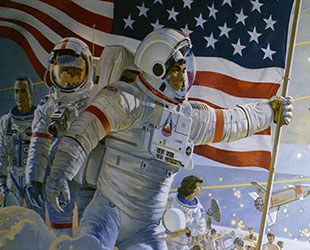
A small part of the large mural "Opening the Space Frontier: Next Fiant Step" at Johnson Space Center by Robert McCall. (NASA) |
"I was painting that mural in Building 2," described McCall of "Opening the Space Frontier: The Next Giant Step," a 71-foot by 16-foot mural that features the progression from Mercury to space shuttle, including the STS-1 commander as the central figure. "It was in the early days of working on it, [that] I was asked by John Young to design the STS-1 mission emblem and eagerly consented to do that."
This wasn't McCall's first patch. He had previously been asked to design the insignia for the Apollo 17 mission.
"I loved that opportunity by the way," says McCall. "It is something I continue to covet because it was wonderful to really see this emblem that I designed on the Moon, in real time from Mission Control."
Nor was McCall's experience limited to the Apollo and earlier U.S. programs. In addition to working on the JSC mural, McCall had seen a shuttle firsthand even before the first launch.
"I had seen the rollout of the 'Enterprise' at Edwards, California, Dryden Flight Research Center area, so I knew the Space Shuttle," said McCall, "and of course [from] pictures and schematics and drawings and architectural drawings and so forth. So I was very well acquainted with the shuttle before that first mission occurred and before I designed this mission emblem."
"It was a fascination for me, as all things having to do with our space program have been through the years."
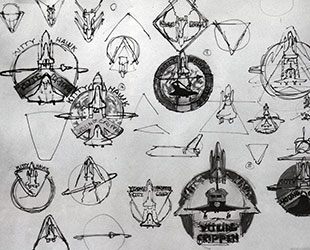
Early sketches by artist Robert McCall of the STS-1 emblem. "Kitty Hawk" was, according to McCall, the STS-1 crew's preferred name for their vehicle before "Columbia" was selected. (McCall Studios) |
As soon as he "knew the mission," McCall began putting pencil to paper, and paper and paper.
"There were many, many ideas. And when I say many, maybe 25 or 30."
McCall however, wasn't the only one with ideas.
"John Young pretty much designed [the emblem]," said McCall. "That is, he gave me a rough pencil outline of some of the elements that he thought should be part of it and then I made sketches including those elements that were important to him and Bob Crippen."
"Then I made a very comprehensive sketch that both John and Bob approved of and then I proceeded to make a painting."
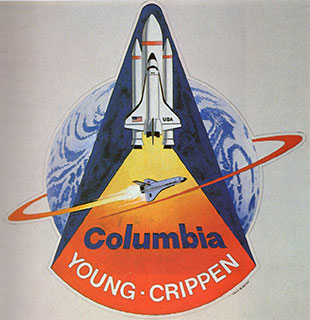
Robert McCall's 1979 painting of the STS-1 crew emblem. The final art was gifted by McCall to astronaut John Young. (McCall Studios) |
McCall's (and Young's) design was "simple and direct".
"The sphere of the Earth is in the background and overlaying that sphere is a rough triangle. At its apex is the shuttle, rising and then tanks are firing. There is another rough triangle of brilliant color from yellow to red, symbolizing the blast of the engines. Within that red is the word 'Columbia' and then below that 'Young' and 'Crippen', the crew members. There is an orbital disc, or an orbital oval that surrounds the Earth in the background and a shuttle right immediately beneath the [launching] Space Shuttle, a small shuttle, showing the orbit of that shuttle around the Earth," described McCall.
"I think it is one of the better mission emblems that I have designed."
McCall and his wife Louise attended the launch of STS-1 and were with Young's wife just a few days before.
"[Susy] was very nervous about it all, as we all were, because it was the first flight and there was no subtle approach to learning the characteristics of the shuttle," explained McCall. "It had to be flown full power from the first moment unlike an experimental aircraft which you can kind of ease into: you taxi it, you have taxi tests, low performance [flights] and finally you test it fully. The shuttle being very different, it had to be flown immediately from the launch pad. So, everyone was nervous about it and they had reason to be as we've learned since."
But the worry had been for naught, and STS-1 with Young and Crippen at the controls landed safely on April 14. One month later, the crew and McCall were back in Florida to debut a new set of stamps designed by the artist.
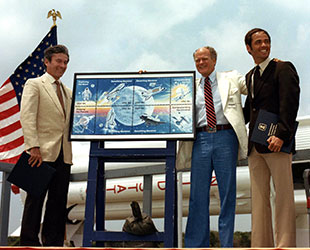
John Young (left) and Bob Crippen (right), together with artist Bob McCall, display the U.S. Space Achievement stamps at a ceremony held at the Kennedy Space Center on May 21, 1981. (NASA) |
"[The stamps] were designed and painted, the actual artwork was done for the U.S. Postal Service before that first mission because the stamps were issued at a programmed event at Cape Kennedy, in the vicinity the building where the shuttle was then taken after it landed and was flown back to the east coast. Louise and I were present when John and Bob were viewing the space shuttle after it landed and they were part of the ceremony of the issuance of that stamp. Actually, it is a series of eight stamps, all connected," recounted McCall.
And what did Young think of McCall's design? Despite the artist giving credit to the astronaut, Young disagreed.
"Bob McCall designed the patch. He's a great fellow. He really does good work on the patches," said Young in an interview with collectSPACE.
For McCall, the privilege was all his.
"It was an important time in my life. I've had a lot of what I regard as important times, but this was significant and special," said McCall.
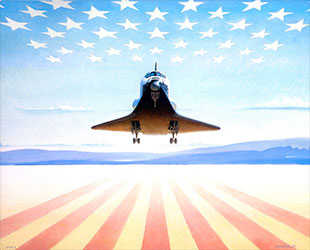
A 1981 painting by Robert McCall interpreting the landing of space shuttle Columbia after the STS-1 mission. (McCall Studios) |
